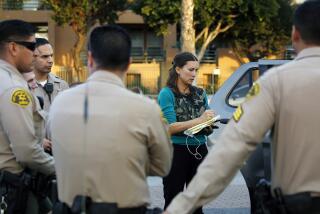LAPD scandal opens window into California’s secret gang database as reforms debated
Brian Allen wasn’t surprised when he recently heard officers in the Los Angeles Police Department may have fabricated evidence to label people as gang members.
He believes it happened to him, landing him on CalGang, the state’s secretive database of criminal street syndicates and their suspected crews that is in the middle of a contentious reform process.
In June, after a two-year fight that ended in front of a Superior Court judge, the Los Angeles city attorney agreed to take Allen off the gang list — acknowledging in court documents that he’d been added based on nothing more than a single interview by officers who had conducted a traffic stop on Allen in 2017 as he drove home through South L.A., information Allen said was “no evidence, all speculation.”
While Allen was on CalGang, he worried often about the consequences, that if “I didn’t blink my blinker or I didn’t stop at a stop sign, just something small could turn into something big,” he said.
“For the couple years I was on there, I felt probably like 90% of other black American kids in the ’hood, like [police] didn’t care. Like it was a setup,” Allen said recently.
The state Department of Justice has been working to fix CalGang for two years to prevent cases like those of Allen and other questionable gang identifications recently uncovered in the LAPD. But some are worried that the overdue overhaul is in jeopardy, as state Atty. Gen. Xavier Becerra signaled last month that he may backtrack on expected changes. Doing so, critics say, would leave too much latitude in the hands of local law enforcement when it comes to deciding who is in a gang.
The ongoing LAPD scandal, in which at least 20 officers are suspected of falsifying information used to identify gang members, will probably play a central role as Becerra works to finalize the reforms by summer. It goes to the heart of the question that has divided law enforcement from community members when it comes to CalGang: How much trust should be afforded to a system that is largely immune to public scrutiny?
Law enforcement has challenged critics’ fear of unfair additions as rumor without evidence — until now. With the LAPD investigation providing an unprecedented glimpse into how the closely guarded database works, the conversation is shifting.
The LAPD investigation “really is the booster rocket to say this has got to be reformed and it’s got to be reformed not in a superficial way but in a meaningful way,” said Jorja Leap, a gang expert at UCLA’s Luskin School of Public Affairs.
CalGang has been described as an “electronic file cabinet” that contains information about suspected gang members and those in their orbits — currently allowing inclusion of people such as girlfriends or family members. Its precursor began in the 1980s in Los Angeles as the county struggled with rising gang-related violence. It grew in sophistication and scope over the intervening decades, now providing California law enforcement with a quick way to track tens of thousands of suspected criminals across jurisdictions — not just by name, but by intelligence that officers collect in field interviews and investigations, such as tattoos, nicknames, cars and associates.
The public has no access to CalGang. Only approved law enforcement can see the more than 88,000 records on it, even to check their accuracy.
Using anecdotal evidence like Allen’s experience, critics have argued that under current rules, overzealous officers can use anything from a sports jersey to a casual conversation with a gang member as proof that a person belongs on CalGang. Because agencies are not required to share what evidence they used — even when a person goes to court to fight the label, as removal sometimes requires — those on the CalGang list often have no idea what prompted their inclusion. It has been nearly impossible for those outside law enforcement to gauge the integrity of the process.
Concerns about CalGang date back to a scathing 2016 state audit, which found that it lacked oversight and that some of the agencies entering alleged gang members, including the LAPD, could not substantiate the claims. Auditors found records for children as young as 1 year old when their names were uploaded, prompting the Legislature in 2017 to put the database under the purview of the attorney general and demand new rules for its use. Until then, it had functioned without state oversight.
Though Becerra audited the existing records in the system, purging thousands of names, thousands more have been added while new rules are debated.
Becerra’s office said in an email that it “is committed to ensuring people’s privacy rights are maintained and that individuals are not wrongly designated as gang members in any shared gang intelligence database in California. We’re committed to holding departments and officers who have misused the system accountable.”
The office did not respond to a question directly about the rollbacks to proposed reforms, but it published a detailed reasoning for each change with the latest draft.
Last summer, Becerra released draft rules that tightened the criteria police could use when labeling someone a gang member. Some legal experts said those original suggested rules would have addressed concerns the database unfairly targets people by race and economic status.
Currently, law enforcement can use information such as the clothing a person is wearing, the neighborhood where police encounter them and identification as a gang member by “reliable” sources to add someone to CalGang. Only two or three of eight possible criteria need to be documented, depending on circumstances.
When Becerra suggested cutting back on the reasons a person could be added, law enforcement members around the state objected.
“The rules were already restrictive enough,” said Jack Schaeffer, president of the San Diego Police Officers Assn. and a gang detective for 12 years. “The whole goal is to make sure we keep track of the most violent predators out there…. When you limit what you can use, it makes it even harder.”
The latest draft, law enforcement members said, is less a reversal than a necessary recalibration. It creates new restrictions, including more internal review before someone is added to CalGang, and also shows an understanding of the role the database plays in fighting street crime.
Schaeffer said leaving broad categories to identify gang members is essential because gangs have grown more pragmatic in evading scrutiny.
“Back in the ’80s, [identification] was really easy because everyone was standing on the corners throwing up gang signs,” Schaeffer said. “But now they are a little more savvy than that.”
Some law enforcement officials argue even the restrictions that remain in the current proposal are too onerous and present a risk to both public safety and officers.
“Knowledge is power,” said Robert Harris, a director of the Los Angeles Police Protective League, the union that represents officers.
Harris said that although his organization is committed to fair rules for CalGang, the changes in the current draft would “undermine the ability for [law enforcement] to put in accurate information or keep that information current and relevant.”
Critics of the latest proposed regulations said that they lack substance by leaving loopholes that allow police to continue adding people to CalGang for the same subjective reasons they have in the past, and that they rely on self-policing by law enforcement to ensure accuracy.
“The test that the attorney general and the Department of Justice should be applying is: Would these regulations have caught this [LAPD] scandal?” said Sean Garcia-Leys, a lawyer withthe Urban Peace Institute in L.A. who has represented people trying to be removed from CalGang. “The most recent draft would not.”
The current LAPD scandal around gang identification began early last year when a Van Nuys mother complained that her teenage son had erroneously been added to CalGang after a field interview with officers. Police supervisors reviewed the body camera footage from the involved officers and found it did not match their accounts, leading to an expanded internal investigation and a recent move by LAPD Chief Michel Moore to fire one of the involved officers.
The LAPD uses CalGang more than any other law enforcement agency in the state. From Nov. 1, 2017, to Oct. 31, 2018, the period covered by a 2018 report by the attorney general’s office, it was responsible for 20,583 records — more than 20% of those in the database. The Los Angeles County Sheriff’s Department had the second-highest count with 17% of total records.
Melanie Ochoa, staff attorney with the American Civil Liberties Union, said the problem with allowing subjective criteria like clothing or the place where police see a person is that they can be discriminatory and are open to abuse. More than 90% of people in the database in 2018 were men of color, predominantly Latino and black, according to data from the California Department of Justice.
“No matter how good the regulations are, there are always going to be officers who try to subvert them in some way,” Ochoa said.
Being seen at “gang-related addresses” could be understood by law enforcement to include places like local markets or intersections, Ochoa said.
“Entire neighborhoods are being swept in,” she said. “It’s code for criminalizing places where black and brown people live.”
Advocacy groups have also criticized CalGang for being too difficult to be removed from, despite a new process put in place with the 2017 legislation. Individuals can ask to be removed by the law enforcement agency that put them on the list or, if the request is denied, petition the California Superior Court to order the agency to remove them.
But Garcia-Leys and others said the process can be costly and time-consuming, with little guarantee of success. Advocates said there is little uniformity with courts or law enforcement agencies when it comes to the process for removal, and many of those on CalGang either don’t know they’re on it or can’t navigate the red tape of removal.
According to the report by the attorney general’s office, only 53 requests for removal were made to law enforcement agencies out of the more than 88,000 records in the database from Nov. 1, 2017, to Oct. 31, 2018. The San Bernardino County Sheriff’s Department and the LAPD received the highest number of requests. San Bernardino County granted three of 18 requests, and the LAPD denied all 15 it received. LAPD spokesman Josh Rubenstein said the department plans to review those denials. LAPD spokesman Josh Rubenstein said the department plans to review those denials.
But as the CalGang debate continues, so does its use.
On Nov. 2, Daeron Funtila, 29, was pulled over in his neighborhood near Vernon and Western avenues with his 7-year-old son in the car. He was given a warning for speeding, but weeks after the traffic stop, Funtila received a letter like Allen’s: Funtila, an auto mechanic, had been added to CalGang.
Funtila was released from prison in 2017 and said he worries the gang designation will make him a target for law enforcement.
“Since I’ve been out of prison, I’ve gotten off parole, I’ve done everything I needed to do to be a model citizen,” he said. “People that don’t even know me, don’t have no idea about me, can just label me and it sticks.”
More to Read
Sign up for Essential California
The most important California stories and recommendations in your inbox every morning.
You may occasionally receive promotional content from the Los Angeles Times.













